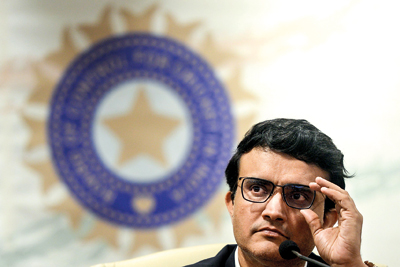Who scripts Sourav Ganguly’s life story?
 The Wankhede Stadium and its precincts have been second home to Sourav Ganguly (Eden Gardens is obviously first!), but who would have thought he would be occupying the office of the Board of Control for Cricket in India (BCCI) president in the Cricket Centre so early?
The Wankhede Stadium and its precincts have been second home to Sourav Ganguly (Eden Gardens is obviously first!), but who would have thought he would be occupying the office of the Board of Control for Cricket in India (BCCI) president in the Cricket Centre so early?
After almost 60 years, an Indian captain has become the BCCI president. The only other previous instance is of the Maharjah of Vizianagram holding this office. Since “Vizzy” was known more for his diabolical machinations rather than any ability as player, Ganguly becoming president is path-breaking.
Developments over the past eight to 10 days that finally brought him into this coveted office on Wednesday were dramatic and unexpected. Some critics and observers have argued that this was politically influenced since home minister Amit Shah met several members before the reconstituted BCCI came into existence.
It is pertinent to mention, however, that national politics getting immersed in cricket administration is hardly new. Political parties of all ideological bents have been seduced by the popular appeal and power (financial and otherwise) of the cricket for decades.
Past BCCI presidents include NKP Salve, SK Wankhede, Madhavrao Scindia (Congress), Sharad Pawar (Nationalist Congress Party). The late Arun Jaitley (Bharatiya Janata Party) was in line to assume the post, but chose to devote time to politics after his party won in the general elections in 2014.
Ganguly has pooh-poohed suggestions of a political deal, as in being made BCCI president. Whether he has ambition for being in national politics – and if so in which ideological direction – will doubtless be speculated unceasingly over the next couple of years. But that is not germane to the matter of cricket administration.
Ganguly’s credentials are outstanding. He’s been a hugely successful player and captain and part of the BCCI administration as well as on International Cricket Council (ICC) committees. He is young, understands the contemporary game and the mind-set of modern players. He’s shown himself to be a clear thinker, decisive and an effective communicator.
These are abundant virtues to make a success of the new task. However, what Ganguly has in very short supply is time. He has already spelt out several things that he wants to tackle. Some such as getting Indian cricket its due from the ICC might take protracted negotiations. Some others, such as bettering the lot of domestic cricketers, could be done with just his signature of approval.
What I would like to see addressed urgently are fighting age-fudging (a major problem as highlighted by Rahul Dravid), and the menace of corruption that has recently come to light in the Tamil Nadu and Karnataka Premier Leagues. There is a long agenda of things to do one could submit to Ganguly, but at this point I’m consumed by nostalgia.
The first time I spoke to him was at Perth, on the 1991-92 tour of Australia. He was a callow 19-year-old who kept largely to himself. He hadn’t been played a single Test, and was obviously disappointed. But of concern were reports swirling around of his being a spoilt brat. One such story was scathing.
It suggested Ganguly had refused to help a fellow player with his kit bag, saying he left such chores to his house help! I broached the subject briefly with him on what was to be his last day of the tour. Ganguly pursed his lips, saying nothing. But his eyes betrayed hurt. I thought he might burst into tears and left it at that.
The problem with such stories, even if based on untruths – or worse, half-truths – is that it can do serious damage to a youngster’s prospects. Administrators and selectors – particularly in those days – did not take kindly to upstarts. Ganguly’s future looked uncertain.
I didn’t hear much about him for almost four years, till he was selected for the tour of England in 1996. When Navjot Sidhu controversially stormed back home after the first Test, Ganguly got a break in the second at Lord’s. He made a century on debut. And another century in the next Test. The smear of 1991-92 had been cleansed in spectacular fashion.
Less than four years later, Ganguly was pitchforked into the captaincy after the match-fixing scam broke and threatened to destroy Indian cricket. Over the next few years, the stock of Indian cricket zoomed as he refashioned the ethos of how India would compete. Just over 10 years after he retired, he occupies the most coveted office in cricket administration.
I hardly need fill in all details of his fascinating 30-plus year career, from junior cricketer to BCCI president. That is well documented and in the public domain. What I want to know is who is scripting Sourav Ganguly’s life?
-Hindustan Times


